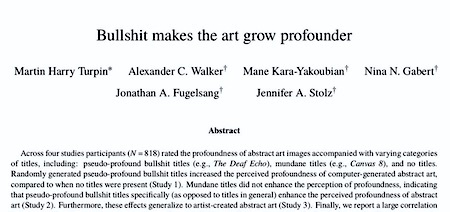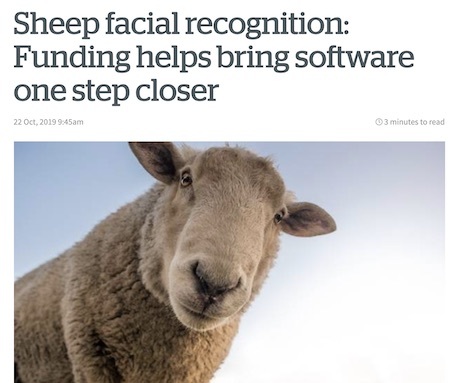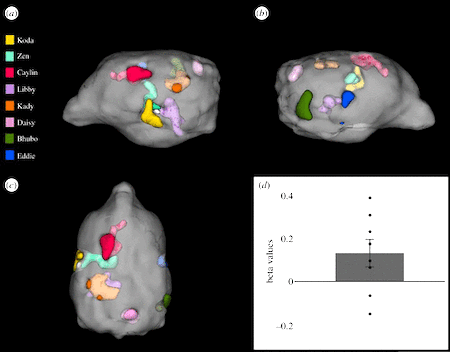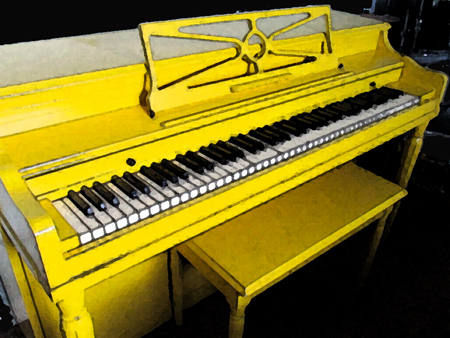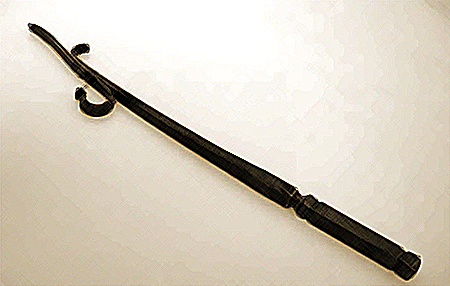Marc Abrahams's Blog, page 128
January 19, 2020
Ig Nobel Prize-winning Black Hole / Hell Expert Jack Van Impe Is Dead
Dr. Jack Van Impe, who discovered the link between black holes and Hell, has crossed the event horizon. He has died, according to news reports.
In 2001, Dr. Van Impe and his wife, Rexella, were awarded the Ig Nobel Astrophysics prize, for their discovery that black holes fulfill all the technical requirements to be the location of Hell. They revealed their discovery on the March 31, 2001 television and Internet broadcast of the “Jack Van Impe Presents” program. (If you can track down the video, you will see it at about the 12 minute mark).
The Van Impes could not or would not attend that year’s Ig Nobel Prize Ceremony. They tentatively planned to come, but eventually informed us, via their secretary, that they had a pre-existing commitment to appear at an event elsewhere.
And so, MIT astrophysicist Walter Lewin accepted custody of the Prize on behalf of the Van Impes. Lewin hailed the Van Impes’ “breakthrough contributions to astrophysics.” He then remarked that, to astrophysicists, “Black holes go beyond our wildest expectations, fantasies and dreams,” that “black holes are heaven to us.”
Here’s video of the prize announcement and the acceptance speech:
Jack Van Impe conducted a long series of scientific and technical research projects, many of which he described during his television broadcasts. In 2007, he announced another grand discovery: that the basic design of the automobile was published in The Bible.
Always, the announcements were made with verve:

January 17, 2020
“Bullshit Makes the Art Grow Profounder” (new research study)
Jonathan Fugelsang, whose team was awarded an Ig Nobel Prize in 2016 for studying the power of pseudo-profound bullshit, has a new study, with other colleagues, about the power of bullshit:
“Bullshit Makes the Art Grow Profounder,” Martin Harry Turpin, Alexander C. Walker, Mane Kara-Yakoubian, Nina N. Gabert, Jonathan A. Fugelsang, and Jennifer A. Stolz, Judgment and Decision Making, vol. 14, no. 6, November 2019, pp. 658-670.
The new study says:
Across four studies participants (N = 818) rated the profoundness of abstract art images accompanied with varying categories of titles, including: pseudo-profound bullshit titles (e.g., The Deaf Echo), mundane titles (e.g., Canvas 8), and no titles. Randomly generated pseudo-profound bullshit titles increased the perceived profoundness of computer-generated abstract art, compared to when no titles were present (Study 1). Mundane titles did not enhance the perception of profoundness, indicating that pseudo-profound bullshit titles specifically (as opposed to titles in general) enhance the perceived profoundness of abstract art (Study 2). Furthermore, these effects generalize to artist-created abstract art (Study 3). Finally, we report a large correlation between profoundness ratings for pseudo-profound bullshit and “International Art English” statements (Study 4), a mode and style of communication commonly employed by artists to discuss their work. This correlation suggests that these two independently developed communicative modes share underlying cognitive mechanisms in their interpretations. We discuss the potential for these results to be integrated into a larger, new theoretical framework of bullshit as a low-cost strategy for gaining advantages in prestige awarding domains.
Here’s further detail from the study:
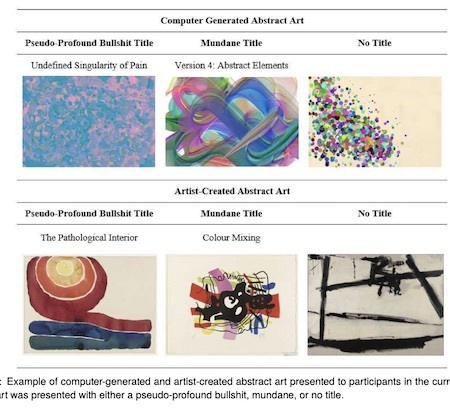

January 15, 2020
Sheep facial recognition software efforts in New Zealand
Sheep facial recognition software is in the offing, suggests an October 22, 2019 news report in the New Zealand Herald:
The world’s first sheep facial recognition software, developed in Dunedin, is set to be prototyped this year.
Sheep NN, a project created by artificial intelligence and machine learning company Iris Data Science, has received a $40,000 grant from Callaghan Innovation towards the $100,000 project that will take the model to prototype by the end of the year.
(Thanks to Mason Porter for bringing this to our attention.)

January 13, 2020
The load on a human hair during combing [study]
 “The objective . . .” of a 2018 research project from the Fashion Business School, London College of Fashion, and Dr Chris Gummer at Cider Solutions Ltd., Chilworth, UK, was “ . . . to assess the frequency and magnitude of combing forces on individual hairs against a hypothesis that fibres on a consumer’s head rarely experience significant loads during routine combing.”
“The objective . . .” of a 2018 research project from the Fashion Business School, London College of Fashion, and Dr Chris Gummer at Cider Solutions Ltd., Chilworth, UK, was “ . . . to assess the frequency and magnitude of combing forces on individual hairs against a hypothesis that fibres on a consumer’s head rarely experience significant loads during routine combing.”
So, what is the load on a human hair during combing?
“During combing, individual fibres may not experience any significant load and are unlikely to experience repetitive loads >10g “
See: Measuring the frequency of consumer hair combing and magnitude of combing forces on individual hairs in a tress and the implications for product evaluation and claims substantiation in the International Journal of Cosmetic Science, Volume 40, Issue 5.
BONUS: Does anti-ageing advertising have a future? by Dr Chris Gummer at Cider Solutions Ltd..
Image credit : Dante Gabriel Rossetti – Woman Combing Her Hair (1865)

January 10, 2020
The Professor Who Says He Knows Love
Love is, to many researchers, so difficult to define that no one can grasp it scientifically.
BUT… some researchers are undaunted in trying to understand and control love. Perhaps preeminent among the dauntless is Robert J. Sternberg, professor of development at Cornell University.
Professor Sternberg’s web page proclaims:
EXCITING ANNOUNCEMENT:
If you’re interested in my theory of love and how to use research-based information to discover, maintain, and nurture the love relationship of your dreams, check out my new website here.
You’ll find lots of science-based information, ideas, and tools how to turn your dreams about love into reality.
Professor Sternberg professes a—perhaps the— Triangular Theory of Love.
Cited for Being Cited
Professor Sternberg’s web page explains, also, that Professor Sternberg is cited for being cited:
He has been cited by ISI for being one of the most highly cited (top ½ of 1%) among psychologists and psychiatrists.

January 8, 2020
Dogs versus Humans in counting
A new study says, more or less, that dogs can count. The study bases this on indirect, fMRI data. You may find the evidence persuasive:
The study does not mention that there are many studies, done in many classrooms, showing that many people cannot count.
This new dog study is: “Canine sense of quantity: evidence for numerical ratio-dependent activation in parietotemporal cortex,” Lauren S. Aulet, Veronica C. Chiu, Ashley Prichard, Mark Spivak, Stella F. Lourenco, and Gregory S. Berns, Biology Letters, December 2019.

Podcast Episode #201: “Crunchiness Loss”
Crunchiness Lost, Clever Contraptions to Trap Crooks, Shoe-Throwing at Weddings, Untied Laces Across the World, Moving Violations of Washing Machines, Stool Pigeons, Clothes for Clothes Shopping, Tanning Beds, Frozen Mammoth Meat, and Neurological Damage from Praying.
In episode #201, Marc Abrahams shows some unfamiliar research studies to Jean Berko Gleason, Richard Baguley, Robin Abrahams, Bruce Petschek, and Chris Cotsapas. Dramatic readings and reactions ensue.
Remember, our Patreon donors, on most levels, get access to each podcast episode before it is made public.
1. Jean Berko Gleason encounters:
“Crunchiness Loss and Moisture Toughening in Puffed Cereals and Snacks,” Micha Peleg, Journal of Food Science, epub July 29, 2015.
“A Study of the Effects of Water Content on the Compaction Behaviour of Breakfast Cereal Flakes,” D.M.R. Georget, R. Parker, and A.C. Smith, Powder technology 81, no. 2 (1994): 189-195.
2. Richard Baguley encounters:
Mike Hall’s “Drive-up Teller Window Protection Apparatus” (U.S. patent 3956997, granted 1976)
Louis J. Marcone’s “Dog-tracking Scent Dispensing System for Apprehending Burglars and the Like” (U.S. patent 4867076, granted 1989)
Philip David Jones, Alan Hickling, and Ruth Marjorie Hickling’s “Soft Restraining System” (U.S. patent application 20050240132, G.B. patent application 211771)
3. Robin Abrahams encounters:
“Shoe-Throwing at Weddings,” James E. Crombie, Folklore, vol. 6, no. 3, 1895, pp. 258–81.
4. Jean Berko Gleason encounters:
Mörth, Ingo (2007). ‘The Shoe-lace Breaching Experiment.’ Figurations: Newsletter of the Norbert Elias Foundation 2 (27): 4–6.
Elias, Norbert (1967). ‘Die Geschichte mit den Schuhbändern.’ Die Zeit, 17 November.
5. Richard Baguley encounters:
Conrad, Daniel C., and Werner O. Soedel (1995). ‘On the Problem of Oscillatory Walk of Automatic Washing Machines.’ Journal of Sound and Vibration 188 (3): 301–14.
Whiteman, Wayne E. and Kip P. Nygren (1999). ‘Basic Vibration Design to Which Young Engineers Can Relate: The Washing Machine.’ Paper presented at the annual meeting of the American Society for Engineering Education, Charlotte, N.C., 20–23 June, session 3268.
6. Jean Berko Gleason encounters:
“Self-Control by Pigeons in the Prisoner’s Dilemma,” Forest Baker and Howard Rachlin, Psychonomic Bulletin and Review, vol. 9, no. 3, September 2002, pp. 482-8.
“Customer Service as a Function of Shopper’s Attire,” Pamela C. Regan and Veronica Llamas, Psychological Reports, vol. 90, no. 1, February 2002, pp. 203-4. The authors are at California State University, Los Angeles.
“Why Do Young Women Use Sunbeds? A Comparative Psychological Study,” B. Fiala, M. Kopp, and V. Gunther, British Journal of Dermatology, vol. 137, no. 6, December 1997, pp. 950-4.
7. Bruce Petschek encounters:
“Was Frozen Mammoth or Giant Ground Sloth Served for Dinner at the Explorers Club?” Matt Davis, Jessica R. Glass, Timothy J. Walsh, Eric J. Sargis, and Adalgisa Caccone, 2015 GSA Annual Meeting in Baltimore, Maryland, USA (1-4 November 2015), Paper No. 327-16.
8. Chris Cotsapas encounters:
Ilic, Tihomir V., Monika Pötter, Iris Holler, Günther Deuschl, and Jens Volkmann (2005). ‘Praying-Induced Oromandibular Dystonia.’ Movement Disorders 20 (3): 385–86.
Scolding, N. J., S. M. Smith, S. Sturman, G. B. Brookes, and A. J. Lees (1995). ‘Auctioneer’s Jaw: A Case of Occupational Oromandibular Hemidystonia.’ Movement Disorders 10 (4): 508v9.
Bruce Petschek, Audio Engineer
Jon Shedler, Audio Engineer
Seth Gliksman, Production Assistant
Available on Spotify, Apple Podcasts, Overcast, Google Podcasts, AntennaPod, BeyondPod and elsewhere!

January 6, 2020
Cheek preferences on Instagram’s chimpanzee pics [new study]
 When people post pictures of chimpanzees to Instagram®, do they have a preference for choosing pictures which display the chimp’s right cheek – or the left cheek?
When people post pictures of chimpanzees to Instagram®, do they have a preference for choosing pictures which display the chimp’s right cheek – or the left cheek?
Dr Annukka Lindell, who is a senior lecturer in psychology at the Department of Psychology and Counselling, School of Psychology and Public Health, La Trobe University, Bundoora, Australia, performed a study in 2019 which has taken steps to help resolve the question.
“Two thousand photographs were sourced from Instagram’s ‘Most Recent’ feed using the #chimpanzee, and coded for pose orientation (left, right) and portrait type (head and torso, full body). As anticipated, there were significantly more left cheek (57.2%) than right cheek images (42.8%), with the bias observed across both head and torso and full body portraits. Thus humans choose to depict chimpanzees just as we depict ourselves: offering the left cheek.”
See: Humans’ left cheek portrait bias extends to chimpanzees: Depictions of chimps on Instagram in the journal Laterality : Asymmetries of Brain, Behaviour, and Cognition, Latest Articles.
Note: The internet domain name ‘Chimpstagram.com’ has already been registered.
Research research by Martin Gardiner

January 5, 2020
Forensic professor news: Piano-sentence and Poker/Rock/Scissors
El Espagnol reports “The rocambolesque story of the psychiatrist who ‘scammed’ the US and was sentenced to play the piano“.
The news article begins [here machine-translated from Spanish to English]:
An American psychiatrist has recently been reprimanded by the US Government Office of Integrity in Research, after having already been convicted. His crime: steal several thousand dollars from the authorities and do it through fakes in clinical trials in his field, one as delicate as mental health….
Condemned to play the pianoIt would be for his tears or for the benevolence of the judges, but the case is that the Austrian psychiatrist did not have to enter prison. On the contrary, the judge issued a curious sentence: Neumeister was sentenced to play the piano for one hour twice a week for needy groups from four locations near New York. The magistrate revealed that she had seen in the documentation that the psychiatrist also had the piano career….
(Thanks to Ivan Oransky for bringing this to our attention.)
Another academic in the news: Poker/Rock/Scissors
The Boston Globe reports about another rocamboleque criminal case involving an academic, who is accused of engaging in the practice of poker/rock/scissors:
A Mount Holyoke College art professor was arraigned Friday on charges of attempted murder after she allegedly attacked a colleague with a rock, fire poker, and garden shears while the college was on winter break, according to authorities….
BONUS: Further details.
BONUS (unrelated): a very different, form of poker/rock/scissors, and separately, an analysis of poker as paper/rock/scissors

The special Ig Nobel issue of the magazine
The magazine’s special Ig Nobel issue (vol. 25, no. 6) shows and tells all about the 2019 Ig Nobel Prize winners and the 29th First Annual Ig Nobel Prize ceremony, and also the opera (“Creatures of Habit”) that premiered as part of the ceremony). Read some of the articles online.
You can buy the entire issue, or subscribe to the magazine, or treat yourself to some back issues.
Annals of Improbable Research—six new issues per year, all in handy PDF format.

Marc Abrahams's Blog
- Marc Abrahams's profile
- 14 followers




